The Corsair SP (Static Pressure), AF (High Airflow) 120/140mm Fan Review
by E. Fylladitakis on November 25, 2015 8:00 AM ESTCorsair's 120mm Performance
The AF120 Performance and AF120 Quiet Edition
First one up is the 'High Airflow' variant of the 120mm line (non-LED), which comes in Performance and Quiet modes. This is the Performance variant pressure/volume response at 12V and 7V:
Whereas the quiet model has this response - note the axes are the same for both AF120 models in this case.
While both AF120 fans in the graphs above share the same shape and design, with the only difference being their rotational speed, the performance curves are of similar shape but different magnitude. The performance of the AF120 fans is low when the impedance is very high but their volume flow capacity greatly increases when the airflow impedance falls below medium levels.
The SP120 Performance and Quiet Edition
As we move onto the Static Pressure line of fans, featuring fewer but wider fan blades (only 7 vs 11), the expectations lie in higher airflow in high-impedance (dense liquid cooler) scenarios. First up, the Performance model at 12V and 7V:
The Quiet model has reduced fan speeds, which gives a very different graph:
The performance of the SP120 is obviously much different than the AF120, as expected, but is also very different from the performance of the SP140 LED as well. The Performance Edition of the SP120 has an outrageous maximum speed of 2300 RPM and our instruments recorded an outstanding static pressure of 3.42 mmH2O at that speed. The curve declines sharply, with the SP120 displaying mediocre airflow gains as the airflow impedance decreases. It also has a significant stall area within the medium airflow impedance region.
The SP120 Perfomance and AF120 Performance Comparison
As the speed of the SP120 Performance Edition at 7 Volts and the maximum speed of the SP120 Quiet Edition coincide, it can be noticed that the two fans have an almost identical performance curve when operating at the same speed. This is natural as only the rotational speed of the fans differs, the design of the fan itself is identical. But when we compare the SP120 and AF120 variants to each other, we get the following (again, at 12V and 7V)
And in the Quiet versions (note, different axes):
The above two comparisons between the Performance and Quiet versions of the SP120 and AF120 respectively are somewhat unfair. From just a quick look at the graphs, it appears that the SP120 outperforms the AF120 under almost any conditions when both fans are operating at their maximum stock speeds. That however is not correct, as the SP120 versions have a much higher top speed are are in both cases louder. With both the AF120 and the SP120 running at the same speed (and similar noise profiles) we got the following performance curves.
With both fans running at the same speed, the advantages and disadvantages of each design become more apparent. The AF120 provides higher air volume flow in low airflow impedance setups while the SP120 can maintain higher air volume flow levels when the airflow impedance is high. Strangely, even though the SP120 is moving considerably less air while entirely unobstructed, it generates about the same level of noise as the AF120. We can only assume that the large blades of the SP120 generate a very turbulent air flow.


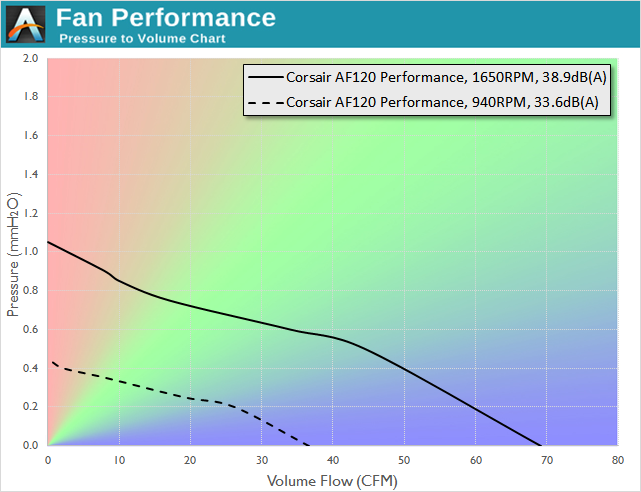
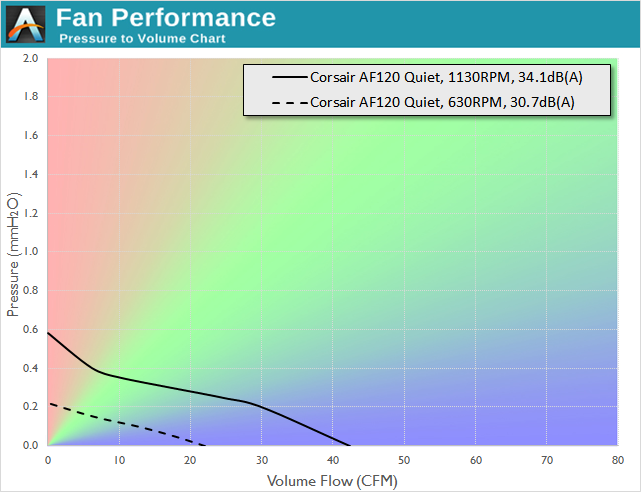
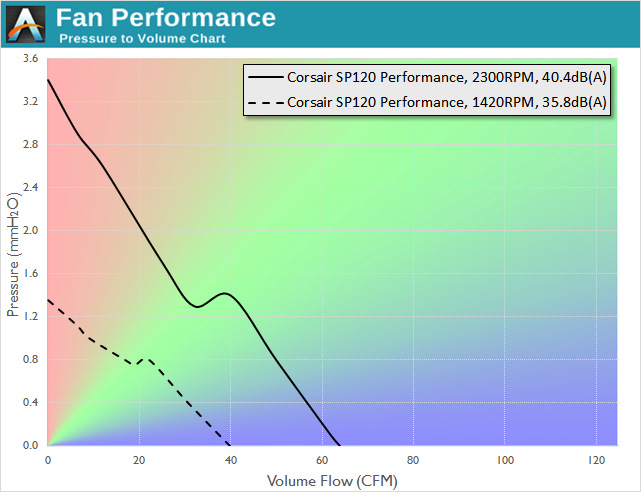
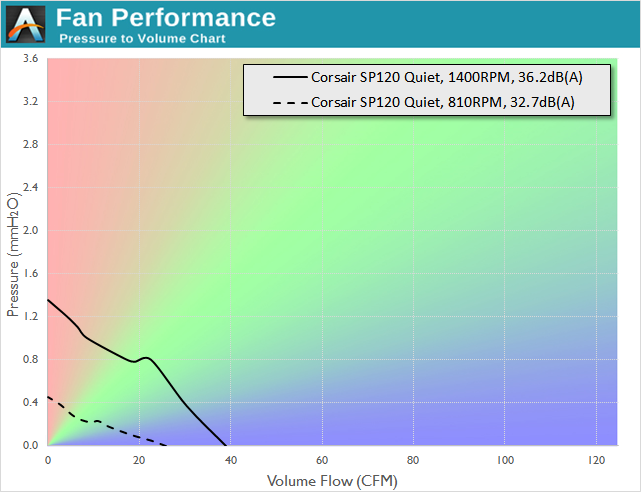

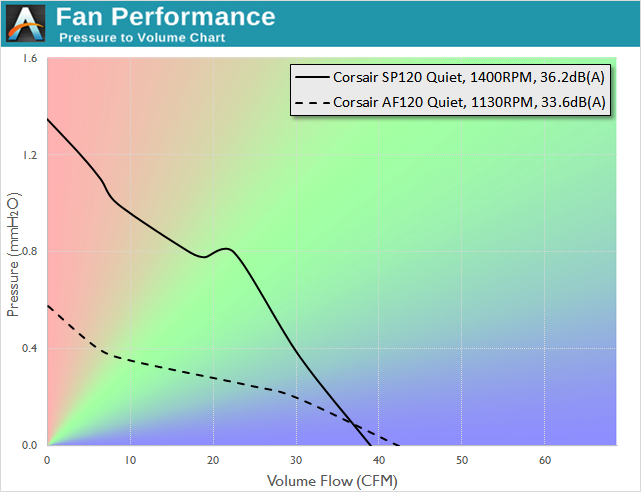
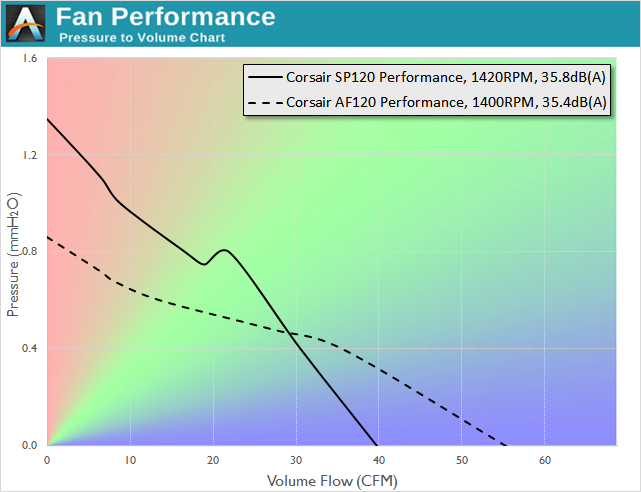








92 Comments
View All Comments
nutral - Thursday, November 26, 2015 - link
He actually did use a anemometer for the airflow test i think. The pitot tube is just used for static pressure readings. I'd say the measuring setup is pretty accurate for what he is doing here. All in all its a great way to measure actual fan performance instead of going after just a flow number and a static pressure number.From my work as an engineer i'm more used to seeing actual graphs of pressure/flow and power to make a good selection. Papst for example does supply them. The only computer fan i've seen else that show these are ek waterblocks
http://img.ebmpapst.com/products/grafik/7438-GRAFI...
https://shop.ekwb.com/media/catalog/product/cache/...
kalboston - Thursday, November 26, 2015 - link
Thank you, I meant to write vane anemometer instead of a pitot tube. As long a the same equipment is to be used these fan comparisons are effective.Just some points to make about the equipment used. Not to say the article is not accurate, but the equipment used is "inexpensive" by trade standards. Such as some of my equipment that I have for those once in a while measurements. The temp/RH, sound, and vibration equipment I own is "cheap" compared to people who specialize in it the field. I wouldn't expect Anand to be using $2,000+ USD thermal anemometers (TSI 9565P temp and barometric compensation) and $2,000+ USD (Shortridge ADM-880C) digital manometers.
The Extech AN200 description does say a thermal anemometer, but the picture shown is a vane anemometer with a FPM accuracy of 3% reading + 40 FPM.
Assuming a 140mm diameter @ 60 CFM = approximately 600 FPM velocity. The AN200 unit is +/- 10% at this reading.
The HD350 accuracy is +/- 0.3% of full scale @ 510 mm h2o = +/- 1.5 mm h2o. Most the readings taken are within the tolerance of the meters accuracy.
I do enjoy reading the author's articles. I have never posted before to Anand, I just hope a few people will hopefully understand before attacking/leaving harsh criticism of the article.
jann5s - Thursday, November 26, 2015 - link
Love the quote in the end, and I'm an engineerTunnah - Thursday, November 26, 2015 - link
Great article, super technical as always, and as usual WAY WAY over my head ha.What I think would be useful is a real world scenario that dumdums like me could look at and see the benefits of. Say, an overclocked CPU with a certain cooler, and the temperature taken with the normal fan, then taken with the custom fan, so we can see the benefit we care about - how much cooler it makes something.
If this isn't possible, due to the fans not fitting, maybe another scenario, a system instead of a CPU cooler, with it's standard fans, then these fans.
I know this probably won't be a popular idea as AnandTech is more for the tech savvy crowd, I just feel like some real world results would help
nutral - Friday, November 27, 2015 - link
This article is mostly about how much flow the fans actually create in certain situations.It can be coupled with how much cooling you have at a certain flow, altough that really depends on the cooler/aio
galta - Thursday, November 26, 2015 - link
Noctua fans, always and forever.The best combination of static pressure and airflow for a given noise level. On top of that, they last close to forever.
Of course, one has to say that they are from beautiful, but that's minor.
Oxford Guy - Thursday, November 26, 2015 - link
They make boring black fans, too.galta - Friday, November 27, 2015 - link
Sure they do. Their industrial line is black/dark brown.I have 6 of them on my system, on a push-pull 3x120mm radiator. Nothing short of superb.
They come at price, though, and not because of their color, but because of their extra specs.
Anyway, as I said before, color is minor.
FriendlyUser - Friday, November 27, 2015 - link
Great, rigorous review!! This is exactly the kind of fan review that I want. Please do a roundup of premium fans soon.Omega215D - Friday, November 27, 2015 - link
Time to compare it to the H.E.C Cougar and Noctua fans.